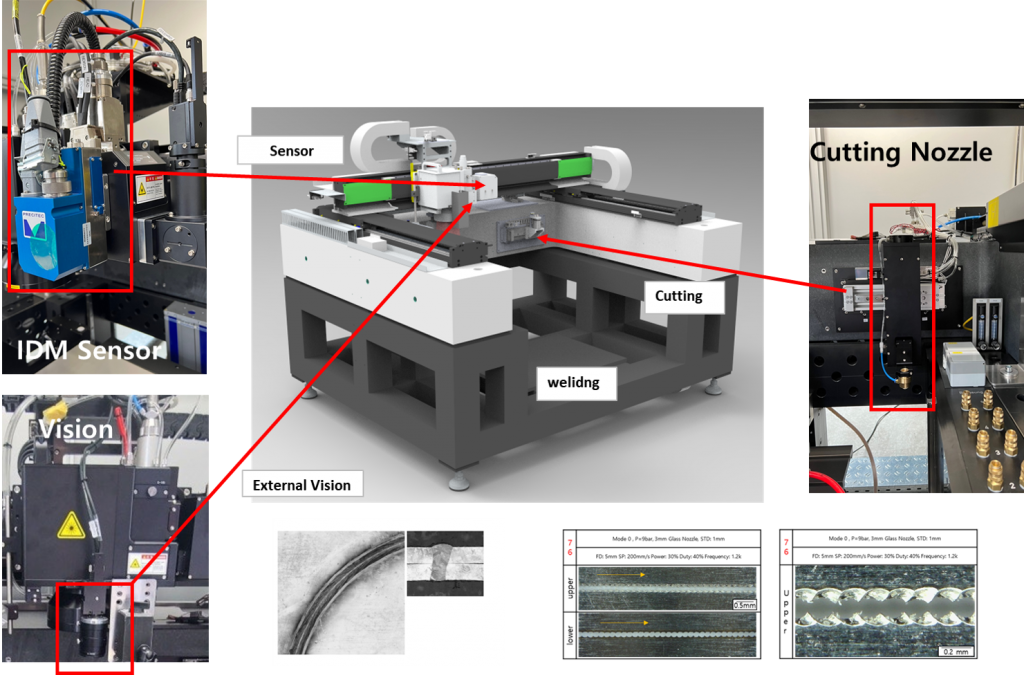Fuel cells used for vessels and airplanes are becoming increasingly lighter to improve efficiency, and this is leading to a decline in the thickness of bipolar plate. In this regard, a laser machining technology for thin bipolar plate, which can help to enhance the production efficiency and quality of fuel cells, has been developed through international R&D innovative collaboration project.
Through international joint research between Korea and Germany, the joint research team consisting of the Korea Institute of Machinery and Materials (President Sang-jin Park, hereinafter referred to as KIMM), an institute under the jurisdiction of the Ministry of Science and ICT, K-Lab, a Korean small and medium-sized enterprise, and Germany’s Fraunhofer Gesellschaft and BBW Lasertechnik GmbH developed a new 2D on-the-fly composite equipment by applying a scanner that allows for laser welding and cutting of materials for bipolar plates for fuel cells with thickness of 0.075mm.
Principal Researcher Su-jin Lee of KIMM Department of Industrial Laser Technology and the joint research team focused their attention on the demands from fuel cell manufacturers that require the welding of large-scale thin plates of various forms as well as high-quality cutting at the same time. The joint research team used the conventional technology where the stage and the scanner move simultaneously, and succeeded in developing a Top-Lamp composite processing machine capable of welding and cutting large areas (400mm x 400mm or larger) in various forms by cross-coupling the cutting gas output nozzle to the stage.
Additionally, the research team developed and utilized the function of maintaining machining accuracy by automatically correcting the work area through the same axle of the scanner and the vision system of the external angle in real-time. Using this function, a technology that enables the correction of the center position of the diameter of the nozzle throat and irradiation of the laser beam within 3mm from the diameter of the nozzle during the process has been applied. The hybrid composite equipment developed as above, which can perform high-speed welding and nozzle cutting at the same time, has been installed at and is being operated by BBW Lasertechnik GmbH, a German partner institution.
With the conventional 2D on-the-fly technology, it has been difficult to precisely control the form of the material because of the change in speed caused by acceleration or deceleration at the time of turnaround (cornering) while the material is being processed. In addition, because it has also been difficult to make corrections to the machining process, it has been necessary to improve the quality thereof. Meanwhile, as it is not easy to attach cutting gas nozzles to conventional high-speed scanners, it has been necessary to use separate equipment for welding and cutting, which has led to increases in processing time and expense.
The newly developed technology helps to enhance machining quality by reducing cross-coupling errors through a more precise position correction by the vision system of the scanner. Additionally, the cutting gas nozzle can be attached separately to the scanner or another stage, improving cutting quality. Furthermore, the vision system corrects the center position for laser beam irradiation at the nozzle throat. This allows high-speed welding and partial cutting at the same time, which helps reducing costs and processing time.
Principal Researcher Su-jin Lee of KIMM was quoted as saying, “The German research team is also expecting that the latest technology, developed through international joint research, will be applicable to various sectors. The newly developed technology is meaningful in that it can respond to the demands from the fuel cell market for the improvement of machining quality as the thickness of bipolar plates for fuel cells becomes increasingly thinner.”
Meanwhile, this research was carried out with the support of the project for the “development of advanced laser machining technologies for the manufacture of fuel cells,” an international co-development project of the Ministry of Trade, Industry and Energy. In May 2022, KIMM signed an MoU with Germany’s Fraunhofer Gesellschaft, one of the institutions that participated in the research, for the expansion of international cooperation and sustainable networking and cooperation among researchers in major fields.
Source: Korea Institute of Machinery and Materials (KIMM).
Tags: Fuel Cells, Germany, Korea, Research Team



Recent Posts
Amogy Accelerates Commercialization of Ammonia Cracking Catalyst in Partnership with JGC
Europa Technologies announces partnership with Twinn
IAC raises the question on India’s absence in LPG autogas vehicles
Montra Electric and Magenta Mobility forge partnership for sustainable logistics solutions
Union Minister Pralhad Joshi visits Greenko’s integrated renewable energy storage project
Government aims at 30% ethanol blending with petrol by 2030
Rio Tinto and AMG Metals & Materials to assess low-carbon aluminium project in India
Gasum selects Wärtsilä for another bioLNG project in Sweden